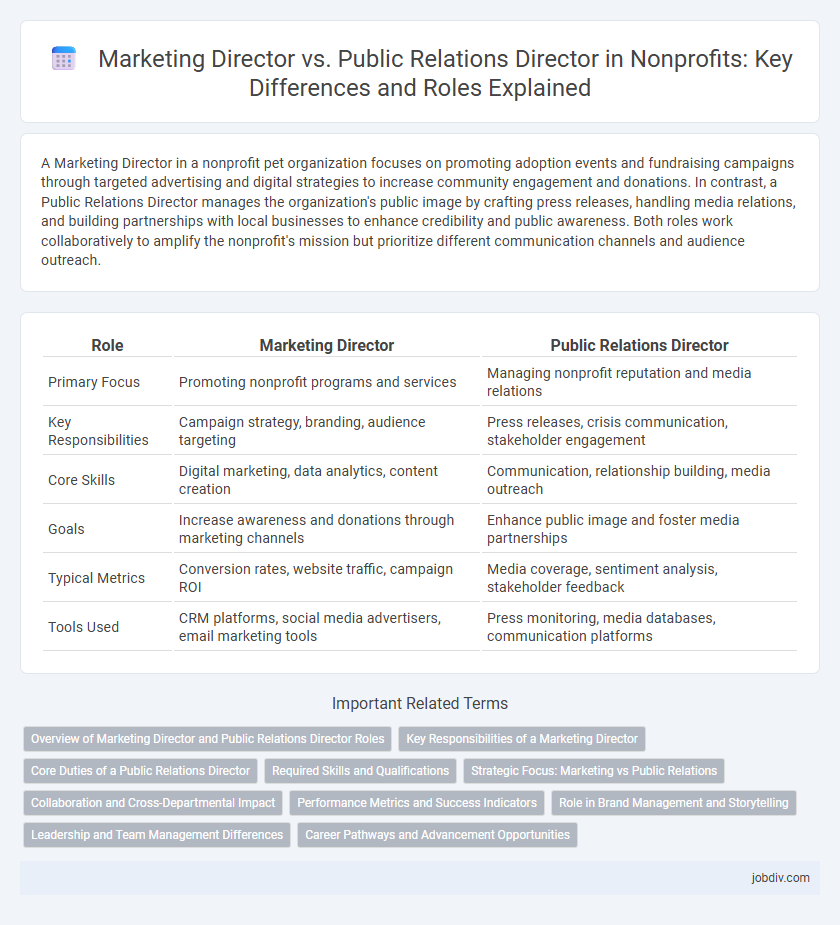A Marketing Director in a nonprofit pet organization focuses on promoting adoption events and fundraising campaigns through targeted advertising and digital strategies to increase community engagement and donations. In contrast, a Public Relations Director manages the organization's public image by crafting press releases, handling media relations, and building partnerships with local businesses to enhance credibility and public awareness. Both roles work collaboratively to amplify the nonprofit's mission but prioritize different communication channels and audience outreach.
Table of Comparison
| Role | Marketing Director | Public Relations Director |
|---|---|---|
| Primary Focus | Promoting nonprofit programs and services | Managing nonprofit reputation and media relations |
| Key Responsibilities | Campaign strategy, branding, audience targeting | Press releases, crisis communication, stakeholder engagement |
| Core Skills | Digital marketing, data analytics, content creation | Communication, relationship building, media outreach |
| Goals | Increase awareness and donations through marketing channels | Enhance public image and foster media partnerships |
| Typical Metrics | Conversion rates, website traffic, campaign ROI | Media coverage, sentiment analysis, stakeholder feedback |
| Tools Used | CRM platforms, social media advertisers, email marketing tools | Press monitoring, media databases, communication platforms |
Overview of Marketing Director and Public Relations Director Roles
Marketing Directors in nonprofits focus on creating and implementing strategic campaigns to promote organizational programs, drive donor engagement, and increase fundraising efforts through data-driven marketing channels. Public Relations Directors concentrate on managing the nonprofit's public image, cultivating media relationships, and handling crisis communication to build trust and support among stakeholders. Both roles require strong communication skills but differ in their core objectives: marketing aims at audience acquisition and revenue growth, while public relations targets reputation management and community relations.
Key Responsibilities of a Marketing Director
A Marketing Director in a nonprofit organization spearheads strategic campaign development to boost donor engagement and event participation, utilizing data-driven insights for targeted outreach. They manage multi-channel marketing efforts, including social media, email, and content creation, to strengthen brand awareness and increase fundraising revenue. Collaborating with fundraising and program teams, they optimize marketing budgets and measure campaign effectiveness through key performance indicators (KPIs) and analytics tools.
Core Duties of a Public Relations Director
A Public Relations Director in a nonprofit organization primarily manages the organization's public image, develops communication strategies, and builds relationships with media outlets to enhance visibility and reputation. Their core duties include crafting press releases, organizing events, and responding to public inquiries to ensure consistent and positive messaging. Unlike a Marketing Director who focuses on promoting programs and fundraising, the PR Director emphasizes maintaining trust and transparency with stakeholders.
Required Skills and Qualifications
Marketing Directors in nonprofits require strong expertise in digital marketing, data analytics, and brand strategy to effectively drive campaigns and donor engagement. Public Relations Directors must possess exceptional communication skills, crisis management experience, and a deep understanding of media relations to maintain the organization's public image. Both roles benefit from leadership ability, strategic thinking, and a thorough knowledge of nonprofit fundraising principles.
Strategic Focus: Marketing vs Public Relations
Marketing Directors in nonprofits concentrate on developing targeted campaigns to drive donor engagement and increase fundraising revenue through data-driven strategies. Public Relations Directors focus on managing the organization's reputation, crafting key messages, and building relationships with media to enhance public trust and support. Both roles strategically align with organizational goals but emphasize external communication differently: marketing prioritizes audience acquisition and conversion, while public relations centers on credibility and narrative control.
Collaboration and Cross-Departmental Impact
Marketing Directors and Public Relations Directors in nonprofit organizations collaborate closely to amplify brand awareness and community engagement, leveraging cross-departmental efforts to align messaging and outreach strategies. Their partnership enhances fundraising campaigns by integrating marketing analytics with media relations, resulting in a cohesive approach to donor communication and stakeholder engagement. Coordinated initiatives between these roles ensure consistent storytelling across platforms, maximizing impact and resource efficiency within the nonprofit sector.
Performance Metrics and Success Indicators
Marketing Directors in nonprofits drive campaign performance through metrics such as lead generation, conversion rates, and donor acquisition costs, emphasizing measurable growth in supporter engagement and fundraising revenue. Public Relations Directors focus on media reach, sentiment analysis, and share of voice to evaluate the impact of brand reputation and public perception on stakeholder trust. Both roles use distinct success indicators to optimize communication strategies and maximize organizational visibility and influence.
Role in Brand Management and Storytelling
A Marketing Director in a nonprofit primarily drives brand awareness through strategic campaigns, audience segmentation, and data-driven messaging that aligns with organizational goals. In contrast, a Public Relations Director focuses on cultivating media relationships, managing public perception, and crafting narratives that enhance the nonprofit's reputation and credibility. Both roles collaborate to ensure consistent storytelling, but the Marketing Director emphasizes market positioning while the Public Relations Director handles external communication and crisis management.
Leadership and Team Management Differences
Marketing Directors in nonprofits focus on strategic campaign development, data-driven audience targeting, and brand positioning to drive donor engagement and fundraising growth. Public Relations Directors emphasize media relations, crisis communication, and reputation management to maintain community trust and stakeholder support. Leadership in marketing involves leading creative teams and analytics specialists, while PR leadership prioritizes managing spokespersons and communication strategists for effective message dissemination.
Career Pathways and Advancement Opportunities
Marketing Directors in nonprofits typically advance through roles in campaign management, digital marketing, or brand strategy, gaining expertise in audience engagement and donor acquisition. Public Relations Directors often rise by building skills in media relations, crisis management, and storytelling, establishing a strong organizational reputation. Career progression for both positions includes opportunities to become Chief Communications Officer or Executive Director, leveraging comprehensive communication strategies to drive mission impact.
Marketing Director vs Public Relations Director Infographic

 jobdiv.com
jobdiv.com